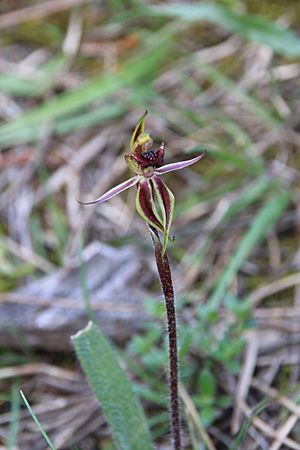Canberra spider orchid facts for kids
Quick facts for kids Canberra spider orchid |
|
|---|---|
 |
|
| Caladenia actensis growing on Mount Majura in the ACT | |
| Conservation status | |
| Scientific classification | |
| Genus: |
Caladenia
|
| Species: |
actensis
|
| Synonyms | |
|
|
The Canberra spider orchid (scientific name: Caladenia actensis) is a special type of orchid that grows only in the Australian Capital Territory (ACT) in Australia. It's called a "spider orchid" because its flowers look a bit like a spider! This plant has just one leaf and usually one greenish flower with cool red patterns. You can only find it in three small areas.
Contents
What it Looks Like
The Canberra spider orchid is a plant that grows on the ground. It's a perennial herb, which means it lives for more than two years. It also has an underground tuber, like a small potato, that helps it store food. These orchids usually grow by themselves or in small groups.
A single leaf appears in late autumn or early winter, after it rains. This leaf is about 40 to 90 millimeters (1.5 to 3.5 inches) long and 6 to 8 millimeters (0.2 to 0.3 inches) wide.
Usually, only one flower grows on a stalk that is about 80 to 140 millimeters (3 to 5.5 inches) tall. The flower is greenish and has many reddish-crimson lines and blotches. It is about 12 to 20 millimeters (0.5 to 0.8 inches) wide.
The top part of the flower, called the dorsal sepal, stands straight up. It's about 15 to 25 millimeters (0.6 to 1 inch) long. The two side sepals are similar in size but point downwards. The petals are about 10 to 15 millimeters (0.4 to 0.6 inches) long.
The most interesting part is the labellum, which is the orchid's special lip. It's shaped like a heart, about 9 to 12 millimeters (0.35 to 0.5 inches) wide. The labellum is maroon or green with a maroon tip. It curves forward and downwards. Along its sides, there are up to six pairs of short, blunt "teeth." In the middle of the labellum, there are four to six rows of dark, purplish-red bumps called calli. These orchids bloom from late September to mid-October.
How it Got its Name
The Canberra spider orchid was first officially described in 1999 by two botanists, David L. Jones and Mark Clements. They published their description in a magazine called The Orchadian. The first plant they studied was found on Mount Ainslie.
The scientific name actensis comes from "ACT," which is short for the Australian Capital Territory. The ending "-ensis" is a Latin word that means "of" or "in." So, actensis means "of the Australian Capital Territory."
Where it Lives
The Canberra spider orchid grows in only three small areas in the ACT. You can find it on Mount Majura, Mount Ainslie, and in the Madura Valley. It likes to grow where woodlands meet forests, often among grasses, small shrubs, and rocks.
Its Ecosystem Role
Like many other orchids, the Canberra spider orchid needs a special helper to grow. It forms a partnership with a type of fungus called Sebacina vermifera. This partnership, called a mycorrhizal association, helps the orchid get nutrients from the soil.
This orchid is probably pollinated by a tiny insect called a thynnid wasp. The wasp helps carry pollen from one flower to another, allowing the orchids to make seeds.
Protecting the Orchid
The Canberra spider orchid is listed as "critically endangered" under a law called the Environment Protection and Biodiversity Conservation Act 1999 (EPBC Act). This means it is at very high risk of disappearing forever.
The main dangers to this special orchid include:
- People walking, riding bikes, or horses in its habitat, which can accidentally damage the plants.
- Building new structures or maintaining existing ones in its living areas.
- Weeds invading its habitat and taking over the space and resources it needs to grow.


